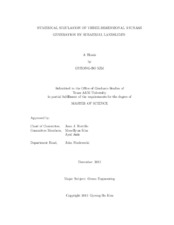| dc.contributor.advisor | Horrillo, Juan J | |
| dc.creator | Kim, Gyeongbo 1978- | |
| dc.date.accessioned | 2013-03-14T16:22:27Z | |
| dc.date.available | 2013-03-14T16:22:27Z | |
| dc.date.created | 2012-12 | |
| dc.date.issued | 2012-09-19 | |
| dc.date.submitted | December 2012 | |
| dc.identifier.uri | https://hdl.handle.net/1969.1/148349 | |
| dc.description.abstract | Tsunamis are one of the most catastrophic natural events impacting coastal regions often generated by undersea earthquakes. Nevertheless, in enclosed basins, i.e., fjords, reservoirs and lakes, subaerial or submarine landslides can initiate devastating tsunamis with similar consequences. Although a subaerial or submarine landslide that impinges into a large water body can generate a tsunami, subaerial landslides are much more efficient tsunami generators than its counterpart. In this study we aim to integrate laboratory scale experiments of tsunami generation by subaerial landslide with numerical models. The work focuses on the numerical validation of two three-dimensional Navier-Stokes (3D-NS) models, FLOW-3D and our developed model TSUNAMI3D. The models are validated based on previous large scale laboratory experiments performed by a tsunami research team lead by Dr. Hermann Fritz, Georgia Institute of Technology. Three large scale landslide scenarios were selected from the set of laboratory experiments, namely, fjord like, headland and far field coastline. These scenarios showed that complex wave fields can be generated by subaerial landslides. The correct definition and evolution of the wave field are key to accurate modeling the ensuing tsunami and its effect in coastal regions. In this study, comparisons are performed between numerical results and laboratory experiments. Methodology and key parameters for soil rheology are defined for model validations. Results of the models are expected to be under the allowable errors indicated by the National Tsunami Hazard Mitigation Program (NTHMP), National Oceanic and Atmospheric Administration (NOAA) guidelines for validation of tsunami numerical models. The ultimate goal of this research is to obtain better tsunami calculation tools for real-world application of 3-D models for landslide tsunamis, which are necessary for the construction of inundation maps in the Gulf of Mexico and the Caribbean regions. | en |
| dc.format.mimetype | application/pdf | |
| dc.subject | Construction of inundation map | en |
| dc.subject | Validation | en |
| dc.subject | Volume of Fluid (VOF) | en |
| dc.subject | Direct Numerical Simulation (DNS) | en |
| dc.subject | Sediment Scour Model | en |
| dc.subject | FLOW-3D | en |
| dc.subject | TSUNAMI3D | en |
| dc.subject | Three-Dimensional Numerical Method | en |
| dc.subject | Navier-Stokes Equation | en |
| dc.subject | subaerial landslide tsunami | en |
| dc.subject | Tsunami | en |
| dc.title | Numerical Simulation of Three-Dimensional Tsunami Generation by Subaerial Landslides | en |
| dc.type | Thesis | en |
| thesis.degree.department | Civil Engineering | en |
| thesis.degree.discipline | Ocean Engineering | en |
| thesis.degree.grantor | Texas A&M University | en |
| thesis.degree.name | Master of Science | en |
| thesis.degree.level | Masters | en |
| dc.contributor.committeeMember | Kim, Moo-Hyun | |
| dc.contributor.committeeMember | Anis, Ayal | |
| dc.type.material | text | en |
| dc.date.updated | 2013-03-14T16:22:27Z | |


